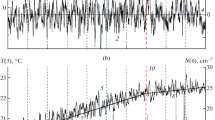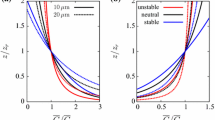Abstract
Vertical turbulent dust-aerosol fluxes over a desertificated area in Astrakhan oblast under almost quasicontinuous saltation conditions have been calculated based on measurements (with a resolution of 1 s) of fluctuations in aerosol-particle concentrations and the vertical wind velocity component. It is shown that the time variability of the density of vertical turbulent dust-aerosol fluxes within a scale range of 30 s to 1 h is determined by convectively caused variations in both horizontal and vertical wind velocity components in the atmospheric surface layer. The normalized turbulent flux or the rate of dust-aerosol removal reaches 4–5 cm/s. The daily variations in vertical turbulent aerosol fluxes are in agreement with those in turbulent heat fluxes. Particle-size dependences of the mass turbulent dust-aerosol flux have been obtained. The method of estimating low-frequency variations in the density of turbulent dust-aerosol fluxes over a desertificated area has been proposed based on measurement data on the wind velocity components and the saltation threshold velocity.







Similar content being viewed by others
REFERENCES
N. Mahowald, S. Albani, J. F. Kok, S. Engelstaedter, R. Scanza, D. S. Ward, and M. G. Flanner, “The size distribution of desert dust aerosols and its impact on the Earth system,” Aeolian Res. 15, 53–71 (2014).
J. F. Kok, E. J. Parteli, T. I. Michaels, and D. Bou Karam, “The physics of wind-blown sand and dust,” Rep. Prog. Phys. 75, 1–119 (2012).
B. A. Mather, J. M. Prospero, D. Mackie, D. Gaiero, P. P. Hesse, and Y. Balkanski, “Global connections between aeolian dust, climate and ocean biogeochemistry at the present day and at the last glacial maximum,” Earth Sci. Rev. 99, 61–97 (2010).
R. Miller, I. Tegen, and J. Perlwitz, “Surface radiative forcing by soil dust aerosols and the hydrologic cycle,” J. Geophys. Res. 109, D04203 (2004).
Y. Balkanski, M. Schulz, T. Claquin, and S. Guibert, “Re-evaluation of mineral aerosol radiative forcings suggest a better agreement with satellite and AERONET data,” Atmos. Chem. Phys. 7, 81–95 (2007).
P. DeMott, K. Sassen, M. Poellot, D. Baumgardner, D. Rogers, S. Brooks, A. Prenni, and S. Kreidenweis, “African dust aerosols as atmospheric ice nuclei,” Geophys. Res. Lett. 30 (14), 1732 (2003).
N. Mahowald and I. Kiehl, “Mineral aerosol and cloud interactions,” Geophys. Res. Lett. 30 (9), 1475 (2003).
J. Hand, N. Mahowald, Y. Chen, R. Siefert, C. Luo, A. Subramaniam, and I. Fung, “Estimates of atmospheric-processed soluble iron from observations and a global mineral aerosol model: Biogeochemical implications,” J. Geophys. Res. 109, D17205 (2004).
A. Krishnamurthy, J. K. Moore, N. Mahowald, C. Luo, and C. S. Zender, “Impacts of atmospheric nutrient inputs on marine biogeochemistry,” J. Geophys. Res. 115, G01006 (2010).
B. Brunekreef and S. T. Holgate, “Air pollution and health,” Lancet 360, 1233–1242 (2002).
S. A. Morman and G. S. Plumlee, “The role of airborne mineral dusts in human disease,” Aeolian Res. 9, 203–212 (2013).
G. S. Golitsyn, I. G. Granberg, A. E. Aloyan, A. V. Andronova, V. O. Arutyunyan, B. V. Vinogradov, E. B. Gabunshchina, G. I. Gorchakov, E. M. Dobryshman, and V. M. Ponomarev, “Study of the thermoconvective removal of arid aerosol in the Kalmykia black lands,” in Natural and Anthropogenic Aerosols (NII Khimii SPbGU, St. Petersburg, 1998), pp. 342–348 [in Russian].
D. A. Gillette, D. A. Blifford, and D. W. Fryrear, “The influence of wind velocity on the size distributions of aerosols generated by the wind erosion of soils,” J. Geophys. Res. 79, 4068–4075 (1974).
B. D. Belan, D. M. Kabanov, and M. V. Panchenko, “Aircraft sounding of atmospheric parameters in a dust experiment,” in The Soviet–American Experiment on Arid Aerosol Studies, Ed. by G. S. Golitsyn (Gidrometeoizdat, St. Petersburg, 1992), pp. 4068–4075 [in Russian].
O. E. Semenov, Introduction to Experimental Meteorology and Climatology of Sand Storms (KazNIIEK, Almaty, 2011) [in Russian].
G. I. Gorchakov, B. M. Koprov, and K. A. Shukurov, “Wind effect on aerosol transport from the underlying surface,” Izv., Atmos. Ocean. Phys. 40 (6), 679–694 (2004).
A. V. Karpov, “Fluctuations of the microstructure of coarse and submicron aerosol in a desertified area,” Opt. Atmos. Okeana 21 (10), 844–849 (2008).
O. G. Chkhetiani, E. B. Gledzer, M. S. Artamonova, and M. A. Iordanskii, “Dust resuspension under weak wind conditions: Direct observations and model,” Atmos. Chem. Phys. 12, 5147–5162 (2012).
G. A. Loosmore and J. R. Hunt, “Below-threshold, non-abraded dust resuspension,” J. Geophys. Res. 105, 20663–20671 (2000).
M. Klose and Y. Shao, “Stochastic parameterization of dust emission and application to convective atmospheric conditions,” Atmos. Chem. Phys. 12, 7309–7320 (2012).
T. Ju, X. Li, H. Zhang, X. Cai, and Y. Song, “Comparison of two different dust emission mechanisms over the Horqin Sandy Land area: Aerosols contribution and size distributions,” Atmos. Environ. 176, 82–90 (2018).
X. L. Liu and H. S. Zhang, “Size distribution of dust aerosols observed over the Horqin Sandy Land in inner Mongolia, China,” Aeolian Res. 17, 231–239 (2015).
X. Y. Li, M. Klose, Y. Shao, and H. S. Zhang, “Convective turbulent dust emission (CTDE) observed over Horqin Sandy Land area and validation of CTDE scheme,” J. Geophys. Res.: Atmos. 119, 9980–9992 (2014).
N. V. Vazaeva, O. G. Chkhetiani, and L. O. Maksimenkov, “Organized roll circulation and transport of mineral aerosols in the atmospheric boundary layer,” Izv., Atmos. Ocean. Phys. 55 (2), 152–166 (2019).
E. A. Malinovskaya and O. G. Chkhetiani, “On conditions of wind-blown removal of soil particles” Vychisl. Mekh. Sploshnykh Sred 13 (2), 175–188 (2020).
S. C. Alfaro, A. Gaudichet, L. Gomes, and M. Maille, “Modeling the size distribution of a soil aerosol produced by sandblasting,” J. Geophys. Res. 102, 11239–11249 (1997).
Y. Shao, M. R. Raupach, and P. A. Findlater, “The effect of saltation bombardment on the entrainment of dust by wind,” J. Geophys. Res. 98, 12719–12726 (1993).
R. A. Bagnold, The Physics of Blown Sand and Desert Dunes (Methuen, London, 1941).
X. Zheng, Mechanics of Wind Blown Sand Movements (Springer, Berlin, 2009).
M. Creyssels, P. Dupont, A. El Moctar, A. Valance, I. Cantat, J. T. Jenkins, J. M. Pasini, and K. R. Rasmussen, “Saltating particles in a turbulent boundary layer: Experiment and theory,” J. Fluid Mech. 625, 47–74 (2009).
S. L. Namikas, “Field measurement and numerical modelling of aeolian mass flux distributions on a sandy beach,” Sedimentology 50, 303–326 (2003).
G. I. Gorchakov, A. V. Karpov, V. M. Kopeikin, I. A. Zlobin, D. V. Buntov, and A. V. Sokolov, “Study of the dynamics of saltating sand grains over desertified territories,” Dokl. Earth. Sci. 452 (6), 1067–1073 (2013).
G. I. Gorchakov, A. V. Karpov, V. M. Kopeikin, A. V. Sokolov, and D. V. Buntov, “Influence of the saffman force, lift force, and electric force on sand grain transport in a wind–sand flow,” Dokl. Earth. Sci. 467 (3), 314–319 (2016).
G. I. Gorchakov, A. V. Karpov, R. A. Gushchin, O. I. Datsenko, and D. V. Buntov, “Vertical profiles of the saltating particle concentration on a desertified area,” Dokl. Earth. Sci. 496 (2), 119–124 (2021).
B. Marticorena and G. Bergametti, “Modeling the atmospheric dust cycle. Part 1: Design of a soil-derived dust emission scheme,” J. Geophys. Res. 100, 16415–16430 (1995).
H. Lu and Y. Shao, “A new model for dust emission by saltation bombardment,” J. Geophys. Res.: Atmos. 104 (D14), 16827–16842 (1999).
M. Sow, S. C. Alfaro, and J. Z. Rajot, “Comparison of the size-resolved dust emission fluxes measured over a Sahelian source with the Dust Production Model (DPM) predictions,” Atmos. Chem. Phys. Discuss. 11, 11077–11107 (2011).
G. I. Gorchakov, B. M. Koprov, and K. A. Shukurov, “Vertical turbulent aerosol fluxes over desertized areas,” Izv., Atmos. Ocean. Phys. 38 (Suppl. 1), S138–S147 (2002).
G. I. Gorchakov, A. V. Karpov, V. M. Kopeikin, D. V. Buntov, R. A. Gushchin, and O. I. Datsenko, “Dust aerosol emission on the desertified area,” Proc. SPIE–Int. Soc. Opt. Eng. 11560, 76 (2020).
G. I. Gorchakov, A. V. Karpov, and R. A. Gushchin, “Turbulent Fluxes of the Dust Aerosol on the Desertified Area,” Dokl. Earth Sci. 494 (2), 799–802 (2020).
G. I. Gorchakov, D. V. Buntov, A. V. Karpov, V. M. Kopeikin, S. F. Mirsaitov, R. A. Gushchin, and O. I. Datsenko, “Wind effect on the size distribution of saltating particles,” Atmos. Oceanic Opt. 33 (2), 198–205 (2020).
G. I. Gorchakov, D. V. Buntov, A. V. Karpov, V. M. Kopeikin, S. F. Mirsaitov, R. A. Gushchin, and O. I. Datsenko, “Vertical profile of saltating particle concentration over semidesert area,” IOP Conf. Ser.: Earth Environ. Sci. 606, 012015 (2020).
D. V. Buntov, R. A. Gushchin, and O. I. Datsenko, “Four-channel photoelectric counter of saltating sand particles,” Atmos. Oceanic Opt. 31 (6), 548–551 (2018).
Funding
This work was supported by the Russian Scientific Fund, project no. 20-17-00214.
Author information
Authors and Affiliations
Corresponding authors
Additional information
Translated by B. Dribinskaya
The paper was prepared based on an oral report presented at the All-Russia Conference on Turbulence, Dynamics of Atmosphere and Climate dedicated to the memory of Academician A.M. Obukhov (Moscow, November 10–12, 2020).
Rights and permissions
About this article
Cite this article
Karpov, A.V., Gorchakov, G.I., Gushchin, R.A. et al. Vertical Turbulent Dust-Aerosol Fluxes. Izv. Atmos. Ocean. Phys. 57, 495–503 (2021). https://doi.org/10.1134/S000143382105008X
Received:
Revised:
Accepted:
Published:
Issue Date:
DOI: https://doi.org/10.1134/S000143382105008X




